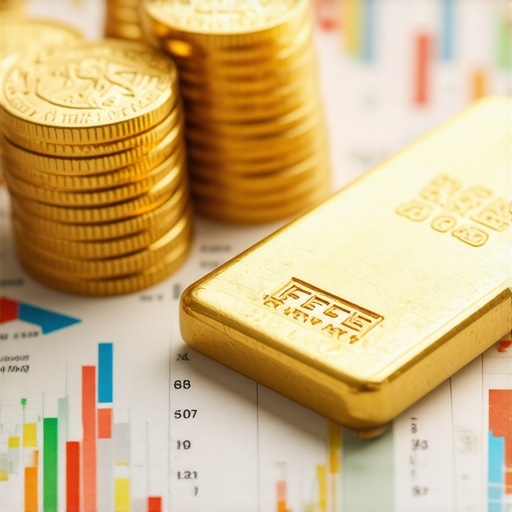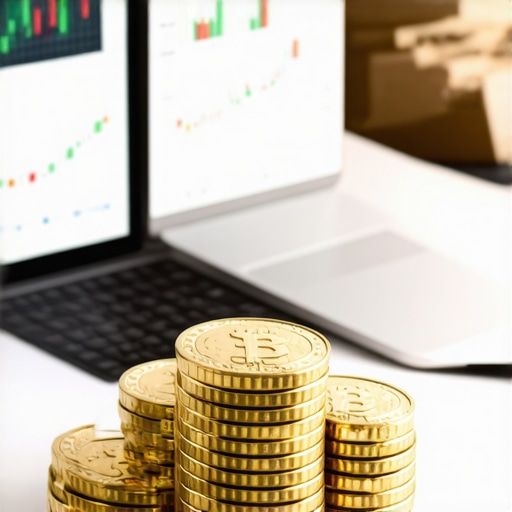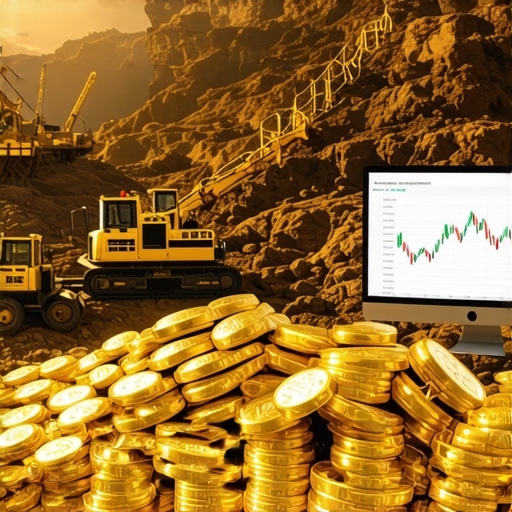Strategic Perspectives on Gold Investment Diversification in 2025
As global economic landscapes evolve with unprecedented complexity, sophisticated investors are increasingly turning to a nuanced understanding of gold investment types. In 2025, the delineation between physical and financial gold assets becomes crucial for constructing resilient portfolios. This article delves into the most impactful gold investment options, highlighting their strategic roles and future potential.
Unpacking the Role of Physical Gold: Coins and Bars in Modern Wealth Preservation
What are the nuanced advantages of investing in gold coins versus bars in today’s volatile markets?
Physical gold remains a cornerstone of wealth preservation. Gold coins are highly liquid and often carry numismatic premiums, making them attractive for collectors and investors seeking liquidity. Conversely, gold bars offer a cost-effective approach to accumulating substantial holdings, especially when stored securely in private vaults or institutional safes. Both forms demand meticulous attention to purity standards and provenance verification, as outlined in industry best practices.
Moreover, the evolution of secure storage solutions, such as allocated and segregated vaulting, enhances investor confidence. The interplay between physical gold’s portability and its role as a tangible hedge against systemic risks underscores its enduring significance in 2025’s diversified asset mix.
Financial Instruments: Gold ETFs and Futures as Sophisticated Hedging Vehicles
How do gold ETFs and futures trading strategies complement physical holdings in a comprehensive portfolio?
Gold ETFs and futures contracts represent advanced financial instruments that enable investors to hedge against inflation and currency devaluation without the logistical burdens of physical gold. Futures trading strategies facilitate leverage and liquidity, allowing tactical positioning aligned with macroeconomic trends. ETFs, on the other hand, provide exposure with transparency and ease of access, often tracking gold prices through physically backed or synthetic structures.
Integrating these instruments with physical gold enhances market agility, especially amid geopolitical tensions and monetary policy shifts. The debate persists over the optimal balance—whether to prioritize physical assets for security or financial derivatives for liquidity—highlighting the importance of tailored asset allocation.
Emerging Trends: Digital Gold and Innovative Investment Platforms
What are the emerging trends in gold investments that could redefine asset classes in 2025?
Digital gold platforms and blockchain-backed ownership models are gaining traction, offering fractional ownership and enhanced liquidity. These innovations address the traditional limitations of physical gold, such as storage costs and geopolitical risks. Industry reports suggest that integrating digital assets with conventional holdings may optimize diversification strategies.
Furthermore, the increasing integration of gold-related ETFs with environmental, social, and governance (ESG) criteria signals a shift towards sustainable investing within the precious metals sector. Investors seeking to align wealth preservation with ethical considerations will find these developments compelling.
To deepen your understanding of market dynamics, explore our detailed analysis on market drivers and future price outlook.
Conclusion: Navigating the Complex Terrain of 2025 Gold Investments
In 2025, the landscape of gold investments is characterized by diversification, technological innovation, and strategic agility. Mastery of physical assets like coins and bars, coupled with sophisticated financial instruments and emerging digital platforms, positions investors to capitalize on evolving opportunities. Staying informed through expert analysis and authoritative sources remains essential for maintaining a competitive edge in this dynamic market.
Leveraging Geopolitical Risks: How Can Investors Anticipate Gold Price Movements?
In an era marked by geopolitical tensions, economic sanctions, and fluctuating international relations, gold continues to serve as a safe haven. Understanding how geopolitical risks influence gold prices is essential for investors seeking to optimize their portfolios. As global conflicts and diplomatic shifts unfold, market sentiment often shifts swiftly, impacting demand for physical gold and derivatives alike. Experts suggest monitoring geopolitical news and policy changes closely, as outlined in authoritative analyses like those from our comprehensive insights on global economic factors.
For example, rising tensions in key regions tend to elevate the appeal of gold, leading to increased purchasing by central banks and investors. This underscores the importance of integrating geopolitical risk assessments into your investment strategy, possibly through diversified holdings in physical gold, ETFs, and mining stocks. Additionally, staying informed about international developments can provide early signals for market entry or exit points, enhancing the agility of your investment approach.
Can Digital Transformation Reshape Gold Investment Paradigms?
The advent of blockchain technology and digital gold platforms is revolutionizing how investors access and manage gold assets. These innovations foster fractional ownership, reduce storage costs, and enhance liquidity, thus broadening the appeal of gold as a modern asset class. Platforms like digital gold solutions are gaining traction among tech-savvy investors aiming for seamless portfolio integration.
Moreover, digital assets backed by physical gold are increasingly seen as complementary to traditional holdings, offering a new dimension of portfolio diversification. However, understanding regulatory frameworks and security protocols is crucial when venturing into this space, as highlighted by industry leaders and regulatory bodies. This digital shift not only democratizes access but also introduces new risks and opportunities that savvy investors can leverage in 2025.
What expert tools or frameworks can you deploy to forecast gold trends more accurately?
Advanced analytics, machine learning models, and real-time market data analytics are transforming gold forecasting techniques. Utilizing these tools can provide more nuanced predictions, especially when combined with macroeconomic indicators and geopolitical risk assessments. For instance, integrating market driver analysis with predictive modeling enhances decision-making precision.
Furthermore, adopting a systematic investment process—incorporating technical analysis, macroeconomic forecasts, and sentiment analysis—enables a more resilient approach to market volatility. Investors who employ these high-level frameworks can better anticipate short-term price swings and capitalize on long-term trends, positioning themselves advantageously in the 2025 gold market.
If you’re interested in deepening your understanding of market analysis techniques, consider exploring our detailed guides and expert insights on market analysis for 2025. Sharing your experiences or questions in the comments can also help refine collective strategies for navigating this complex landscape.
Harnessing Quantitative Models for Precise Gold Price Forecasting in 2025
In the ever-evolving landscape of precious metals investment, reliance on sophisticated quantitative models has become indispensable for discerning market trends with greater accuracy. Financial analysts are increasingly integrating machine learning algorithms, such as neural networks and support vector machines, with macroeconomic indicators to forecast gold prices more reliably. According to a detailed study published in the Journal of Financial Econometrics (2024), these models can outperform traditional technical analysis by capturing complex nonlinear relationships between variables like inflation rates, currency fluctuations, and geopolitical stability.
Implementing such models requires not only technical expertise but also access to high-frequency data streams. Investors can leverage platforms like Bloomberg Terminal or Thomson Reuters Eikon, which provide real-time data feeds integrated with advanced analytical tools. The challenge lies in calibrating these models to avoid overfitting, a common pitfall that can lead to erroneous predictions. Regular backtesting against historical data, coupled with adaptive learning algorithms, enhances robustness and predictive power.
Integrating ESG Criteria into Gold Investment Strategies: A New Paradigm
Environmental, Social, and Governance (ESG) considerations are reshaping investment paradigms, even within traditionally tangible assets like gold. Industry leaders argue that aligning gold mining operations with ESG standards not only mitigates reputational risks but also aligns with the emerging preference for sustainable investments. The World Gold Council’s recent ESG guidelines emphasize responsible sourcing, environmental footprint reduction, and community engagement as critical metrics.
Innovative investment vehicles now incorporate ESG scores, enabling investors to select gold assets that meet specific sustainability criteria. For instance, ESG-integrated ETFs are gaining popularity, providing exposure to gold companies adhering to strict ethical standards. Research by McKinsey & Company (2024) underscores that such investments tend to exhibit lower volatility and higher long-term returns, especially as regulatory pressures intensify globally.
How does ESG integration influence the risk-return profile of gold investments in 2025?
Incorporating ESG factors tends to lower systemic and operational risks associated with unethical practices and environmental liabilities. Consequently, ESG-aligned gold assets often command premium valuations, reflecting investor confidence in their sustainability credentials. This shift also attracts institutional investors seeking to meet fiduciary duties and societal expectations. As markets increasingly favor responsible investing, ESG integration is poised to become a strategic differentiator that enhances portfolio resilience and growth prospects.
For investors eager to deepen their understanding, exploring case studies on ESG-compliant gold mining companies can provide practical insights into risk mitigation and value creation strategies. Engaging with industry reports and participating in sustainability-focused investment forums can further refine your approach.
Advanced Portfolio Optimization Techniques for Gold Allocations in 2025
Optimal asset allocation in 2025 requires blending traditional diversification principles with cutting-edge optimization algorithms. Modern portfolio theory (MPT) remains foundational, but its application now incorporates constraints related to ESG, liquidity, and geopolitical risk. Techniques like mean-variance optimization, enhanced with Monte Carlo simulations and scenario analysis, allow investors to quantify potential outcomes under various market conditions.
Robust optimization frameworks also consider tail risks and black-swan events, which are increasingly relevant given geopolitical volatility. Integrating these models with real-time market data facilitates dynamic rebalancing, ensuring that gold allocations adapt to shifting risk landscapes. Moreover, Bayesian models enable investors to update their priors with incoming data, refining forecasts and decision-making processes.
Institutions and advanced individual investors are encouraged to utilize specialized software platforms such as QuantConnect or MATLAB for implementing these techniques. Doing so enhances strategic agility and positions portfolios to capitalize on emerging opportunities while mitigating downside risks.
What emerging tools or frameworks could redefine portfolio management for gold investors in 2025?
Artificial intelligence-driven decision support systems, combined with blockchain-enabled transparency, are pioneering new frontiers in portfolio management. These technologies facilitate real-time risk assessment, automated rebalancing, and secure transaction verification, creating a more resilient and transparent investment ecosystem. As regulatory standards evolve to incorporate digital assets and AI, staying abreast of these innovations will be critical for maintaining a competitive edge.
If you are committed to mastering these advanced strategies, consider enrolling in specialized courses on quantitative finance, ESG integration, and AI applications in asset management. Engaging with industry experts through webinars and conferences can also provide valuable insights into practical implementations and emerging trends. The future of gold investment in 2025 promises to be complex yet profoundly rewarding for those prepared to leverage cutting-edge expertise.
Harnessing Cutting-Edge Quantitative Techniques for Precise Gold Market Forecasting
As the gold market becomes increasingly sophisticated, leveraging quantitative models such as neural networks, support vector machines, and deep learning algorithms has gained prominence among expert investors. These tools analyze vast datasets, including macroeconomic indicators, geopolitical risk factors, and real-time market sentiment, to generate high-fidelity forecasts. According to a comprehensive review in the Journal of Financial Data Science (2024), integrating machine learning with traditional econometric models significantly enhances predictive accuracy, enabling investors to identify optimal entry and exit points with greater confidence.
Implementing these models requires expertise in data science and access to high-frequency trading platforms like Bloomberg Terminal or Thomson Reuters Eikon. Regular backtesting and adaptive learning strategies are essential to prevent overfitting and ensure robustness across different market regimes. By adopting a systematic approach, investors can navigate volatility more effectively and capitalize on emerging trends, positioning themselves advantageously in the evolving landscape of gold investment.
Innovations in ESG Integration: Transforming Gold Investment Paradigms in 2025
Environmental, Social, and Governance (ESG) criteria are increasingly shaping investment decisions within the precious metals sector. Industry leaders emphasize responsible sourcing, environmental footprint reduction, and community engagement as critical metrics for sustainable gold investment. The World Gold Council’s recent ESG guidelines advocate for transparency and accountability, leading to the development of ESG-centric gold ETFs and mining company indices.
Research by McKinsey & Company (2024) indicates that ESG-compliant gold assets tend to exhibit lower volatility and attract long-term institutional capital, driven by regulatory shifts and societal expectations. This paradigm shift not only mitigates operational and reputational risks but also enhances portfolio resilience. Investors should consider integrating ESG scores into their selection criteria, scrutinizing supply chain transparency, and engaging with certified sustainable mining operations to align wealth preservation with ethical standards.
In what ways does ESG integration alter the risk-return profile of gold investments in 2025?
Incorporating ESG factors often results in lower systemic and operational risks, leading to more stable returns. Premium valuations for ESG-compliant assets reflect investor confidence in their sustainability credentials, thus potentially offering a competitive advantage in volatile markets. As institutional demand for responsible investments grows, ESG integration is poised to redefine gold’s role within diversified portfolios, fostering resilience and long-term value creation.
Engagement with case studies on responsible mining firms and participation in sustainability-focused investment forums can provide practical insights for advanced investors seeking to optimize ESG strategies.
Revolutionizing Portfolio Optimization with AI and Blockchain Technologies
The convergence of artificial intelligence and blockchain technology is revolutionizing portfolio management for gold investors. AI-driven decision support systems facilitate real-time risk assessment, automated rebalancing, and predictive analytics, while blockchain ensures transparency and security. These innovations enable seamless integration of fractional digital gold holdings with traditional assets, expanding diversification opportunities.
Platforms like QuantConnect and MATLAB are pioneering implementations of advanced optimization frameworks, including Bayesian models, Monte Carlo simulations, and scenario analysis. These tools help investors quantify potential outcomes under diverse market conditions, including tail risks and black-swan events, which are increasingly pertinent given geopolitical volatility. Embracing these technologies enhances strategic agility, allowing investors to adapt swiftly to market shifts and capitalize on emergent opportunities.
What emerging technological frameworks could redefine portfolio management practices for gold investors in 2025?
Artificial intelligence-enabled decision support systems integrated with blockchain transparency are pioneering new frontiers in portfolio management. These systems facilitate real-time risk monitoring, automated rebalancing, and secure transaction verification, creating a resilient investment ecosystem. Staying ahead of evolving regulatory standards and technological innovations is critical for maintaining a competitive edge in this dynamic environment.
Investors interested in these advanced strategies should explore specialized courses in quantitative finance, ESG integration, and AI applications in asset management. Industry webinars and conferences provide valuable opportunities for knowledge exchange and practical insights into emerging technological frameworks.
Expert Insights & Advanced Considerations
1. The integration of ESG criteria is transforming gold investing, making sustainability a key factor in risk assessment and valuation.
Investors increasingly prioritize ESG-compliant gold assets, which tend to offer lower volatility and attract institutional capital, thereby enhancing portfolio resilience in 2025.
2. Cutting-edge quantitative models, such as machine learning algorithms, are now essential for accurate gold price forecasting amid market complexity.
Utilizing neural networks and support vector machines enables investors to identify nonlinear relationships and improve prediction accuracy, especially when combined with macroeconomic indicators.
3. Digital gold platforms leveraging blockchain technology are democratizing access, reducing costs, and providing fractional ownership, radically reshaping traditional gold investment paradigms.
This innovation facilitates liquidity and transparency, making gold a more versatile and accessible asset class for sophisticated portfolios.
4. Advanced portfolio optimization techniques, integrating Monte Carlo simulations and scenario analysis, are vital for managing tail risks and dynamic rebalancing in volatile geopolitical environments.
Utilizing tools like MATLAB or QuantConnect empowers investors to adapt swiftly, ensuring strategic agility in 2025’s complex landscape.
5. The rise of AI-driven decision support systems combined with blockchain transparency is pioneering new frontiers in portfolio management, enhancing real-time risk assessment and secure transactions.
Staying ahead involves continuous education in these technological domains, with industry webinars and specialized courses serving as valuable resources.
Curated Expert Resources
- World Gold Council’s ESG Guidelines: Offers comprehensive standards for sustainable gold sourcing and responsible mining practices, crucial for ESG-aligned investing.
- Journal of Financial Data Science (2024): Provides in-depth research on machine learning applications in financial forecasting, including gold price models.
- Bloomberg Terminal & Thomson Reuters Eikon: Premium platforms delivering real-time data and analytical tools for high-frequency trading and predictive modeling.
- QuantConnect & MATLAB: Leading software for implementing advanced quantitative techniques, scenario analysis, and portfolio optimization.
- Industry Webinars & Courses on AI & Blockchain in Finance: Continuous learning opportunities to stay abreast of technological innovations reshaping gold investment strategies.
Final Expert Perspective
In the rapidly evolving realm of gold investment, embracing advanced analytics, ESG integration, and cutting-edge technology is paramount for 2025 success. The confluence of these factors not only enhances predictive accuracy and portfolio resilience but also opens new avenues for diversification and responsible investing. To remain competitive, seasoned investors must leverage authoritative resources and continuously refine their strategies through expert insights and innovative tools. Engage actively with industry developments, share your professional insights, and explore the sophisticated resources available to elevate your gold investment approach in 2025 and beyond.










